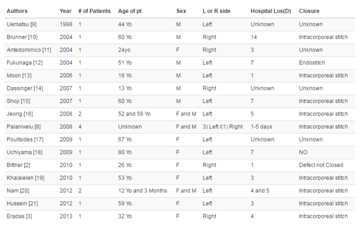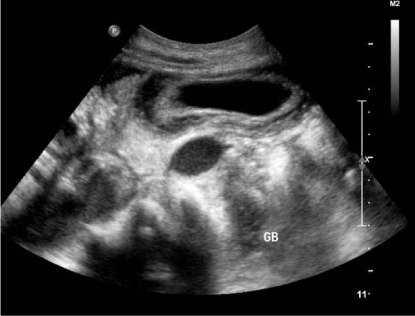Case Report
Acute a Calcular Cholecystitis in a Patient with Brucellosis
Bandar Idrees Ali*
Department of Surgery, Prince Sultan Military Medical City, Saudi Arabia
*Corresponding author: Bandar Idrees Ali, Department of surgery, Prince Sultan Military Medical City, Riyadh, Saudi Arabia
Published: 25 Aug, 2016
Cite this article as: Ali BI. Acute a Calcular Cholecystitis
in a Patient with Brucellosis. Ann Clin
Case Rep. 2016; 1: 1101.
Abstract
Objective: This report was designed to review the critical complication following infection with
Brucellosis. Although acute acalculous cholecystitis is a rare complication of brucellosis, it can
because devastating problems are not treated early and properly.
Case Presentation: Acalculous cholecystitis is strongly associated with a variety of clinical
conditions. The clinical presentation is variable and often depends on the underlying predisposing
conditions. In the critically ill, who may be intubated and sedated, the appearance of unexplained
fever, leukocytosis, or vague abdominal discomfort may be the only clue, and warrants a high
suspicion for the disease. The insidious presentation in such cases is associated with a high incidence
of gallbladder gangrene and perforation. The complications may be manifested by sepsis, shock, and
peritonitis. One of the rare causes of this is brucellosis which is reported in this review.
Discussion: The pathogenesis of acute cholecystitis associated with brucellosis is not well
understood. Clinically, the patient may have all or some elements of the SIRS as well RUQ
tenderness. Radiologically, mostly ultrasound was done and it will show a thickened gallbladder wall
with pericholecystic fluid with or without distention. The gallbladder may contain some fluid which
could be harboring the organism. Medical management of acute cholecystitis caused by Brucella
infection will be regimens include tetracycline or doxycycline with rifampin. The surgical option
will not usually need unless evidence of gallbladder perforation is occurred.
Conclusion: Although the acute cholecystitis is a very rare complication of brucellosis, it should be
kept in mind especially in the endemic area and a typical presentation.
Keywords
Acalculous cholecystitis; Brucellosis
Introduction
Acalculous cholecystitis is an acute necroinflammatory disease of the gallbladder with a
multifactorial pathogenesis. It accounts for approximately 10% of all cases of acute cholecystitis and
is associated with a high morbidity and mortality.
The liver is commonly affected in patients with brucellosis, but the biliary duct is very rarely
involved. We report here the occurrence of acute a calculous cholecystitis in the course of brucellosis.
Case Presentation
A 40-year-old male patient with a 5-day history of Right upper abdominal pain and fever was
admitted to our hospital through ER. A preliminary diagnosis of acute ascending cholangitis was
made. An ultrasound scan showed a thickened gallbladder wall, with partially contracted associated
with pericholecystic edema and fluid with no obvious stone in the common bile duct (CBD) with
normal diameter.
Laboratory data at the time of the admission were as follows: total bilirubin, 93 mmol/l (normal
~ 0-17); direct bilirubin 70mmol/l; alkaline phosphatase, 177 U/l (normal ~38-117); aspartate
aminotransferase, 5U/l (normal ~30); alanine aminotransferase, 10 U/l (normal ~30); g glutamyl
transferase, 45 U/l (normal ~25); serum amylase, 26 U/l (normal ~130); erythrocyte count, 4 700
000 /mm3 (normal 4 000 000–5 400 000); hemoglobin, 13.6 g/dl (normal 12–16); leukocyte count,
5500/ mm3 (normal 4000–10 000) with 41 neutrophils, 45 lymphocytes, 1 monocyte; platelets, 70
000/mm3 (normal 150 000–400 000); albumin 22; creatinine, 127 and erythrocyte sedimentation
rate, 11 mm/h (normal ~15). Because the patient was febrile (39.7C), blood cultures were performed
prior to the start of antibiotic treatment. After second blood cultures were obtained, therapy with
Tazocin 4.5 g and metronidazole 0.5 g was begun. With this treatment, combined with fasting and
i.v fluid with pain killer medications patient’s temperature returned to normal within 4 days. On day
5 after admission, one blood culture was positive. The organism was identified as Brucella. Serology titer showed Brucella Abortus 1: 2560; Brucella melitensis1: 2560.
ERCP showed a normal biliary tree, papillitis noticed with a small
amount of pus came out. CT abdomen showed right side pleural
effusion, free fluid in the pelvis, no liver abscess, contrast seen in the
gallbladder, CBD, bowel loops.
Table 1
Discussion
Brucellosis, like typhoid, is an enteric fever in which systemic
symptoms generally predominate over disorders of the gastrointestinal
tract [1]. Localized brucellosis may result as a complication of
bacteremia and may be the only manifestation of chronic infection.
Bacterial contamination of the gallbladder via the lymphatic
network may occur during a systemic infection such as tuberculosis,
typhoid [2] or brucellosis. Bile cultures are not always positive in
cases of acute cholecystitis: according to a French study performed
in 1991 by Freland.
They are positive in more than 60% of cases at the time of acute
cholecystitis. When the culture is positive, gram-negative bacilli are
usually isolated, but sometimes gram-positive cocci and anaerobic
bacteria are found. Therefore, it is imperative that blood cultures be
performed.
After determining the antibiotic sensitivity of the organism,
therapy was switched to streptomycin 1000 mg and doxycycline 200
mg, according to World Health Organization recommendations [1].
The double antibiotic treatment was continued for 6 weeks.
In this case, brucellosis was certainly linked to contaminated
unpasteurized milk from camel where have been drunk by the patient
& his family. As mentioned by the patient, also his brother admitted
to the other hospital 2 weeks earlier with the same presentation and
diagnosed to have Brucellosis; so all his family members were sent
for screening.
Ingestion of such products is the main cause of contamination in
people working in an environment that is otherwise free of brucellosis risk [3]. Brucellosis was not suspected at the time our patient was admitted.
The diagnosis was reached only when blood cultures were
performed due to the patient’s fever. Cholecystitis occurring as a
complication of brucellosis has been reported as early as 1934 [4,5].
However, this complication is very rare, with only a few cases reported
since 1979 [6]. Cholecystitis is generally a calcular; two recent cases of
Brucella-induced acalculous cholecystitis were reported in the USA
in 1979 [2] and in Spain in 1986 [7]. To the best of our knowledge, only one case of acute calcular cholecystitis associated with Brucella
has been described previously [8]. As in our case, the species of
Brucella involved in cholecystitis is generally melitensis [7], but
Morris et al. [2] reported a Brucella Suis infection. In these previous
cases, blood cultures and bile cultures both were positive at the time
of the infection.
Figure 1
References
- Kanafani ZA, Sharara AI, Issa IA, Kanj SS. Acute calculous cholecystitis associated with brucellosis: A report of two cases and review of the literature. Scand J Infect Dis. 2005; 37: 927-930.
- Morris SJ, Greenwald RA, Turner RL, Tedesco FJ. Brucell induced cholecystitis. Am J Gastroenterol. 1979; 71: 481–484.
- Lopez-Prieto, Aller A, Alcaraz S, Gutierrez de la Pena C. [Acute calculous cholecystitis associated with Brucella melitensis]. Enferm Infecc Microbiol Clin. 2003; 21: 464-465.
- Ashley D, Vade A, Challapalli M. Brucellosis with acute acalculous cholecystitis. Pediatr Infect Dis J. 2000; 19: 1112-1113.
- Survillance of Brucellosis in the Subsaharan area. Report of WHO local region authority. 1996.
- Young EJ. Brucella species. In: Mandell GL, Bennett JE, Dolin R (eds). Principles and practice of infectious disease. Churchill Livingstone. New York: 1995; pp 2060–2068.
- Janbon F: La brucellose en. La Lettre de l’Infectiologue. 1993; 20: 623–627.
- Young EJ, Human brucellosis. Reviews of Infectious Diseases. 1983; 5: 821–842.


